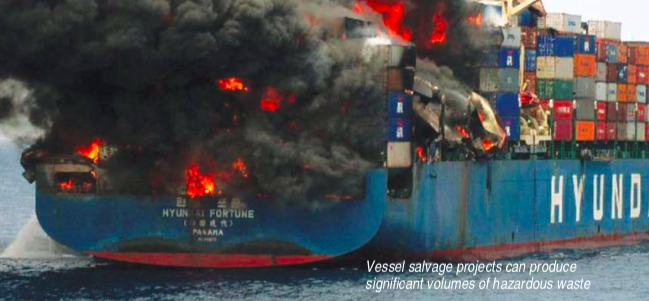Solving the waste management conundrum
Salvage and offshore decommissioning projects tend to produce a high volume and wide range of waste. In the first of a short series of articles for IT&O, Martin Bjerregaard – director of D3 Consulting Ltd, specialist in complex waste management in decommissioning, dismantling and salvage – shares some key thoughts and lessons learned regarding waste management
Determining what type of ‘waste’ is present and which regulations apply is not always an easy task when carrying out a salvage or offshore decommissioning project. One of the first steps is to determine who the applicable regulators are, which regulations apply and, crucially, who is the owner of the waste.
Making this determination will depend on the following key aspects:
- What are the applicable regulations? This is not always easy to determine if the wastes arising from the project are to be transported across national boundaries. For example, a waste may be determined as non-hazardous in one country but classified as hazardous in another depending on the regulatory thresholds for certain chemicals and metals;
- Determine who the relevant regulators are and their authority governing the waste, including potential trans-frontier movement of wastes. Note also that hazardous wastes and materials will lead to health and safety risks and thus additional regulators may be involved above and beyond waste and environmental regulators;
- Clarity and confirmation on who is the owner of the waste and materials. Again this can be convoluted if the owner is registered in a separate country with different laws and regulations from those applicable where the waste is currently located. For example, an owner registered in the EU with waste in a non-EU country could be bound by EU laws, including duty of care with specific responsibilities.
Early engagement with the identified regulators is thus an important prerequisite for a successful project, as there are considerable risks if this is not clarified from the start.
One lesson learned from offshore decommissioning in the UK is the lack of appreciation by operators for their legally required duty of care to ensure that the wastes are managed properly throughout the decommissioning cycle, all the way through to final disposal or recycling. This is not something that an operator can ‘contract’ their way out of.
Once the applicable regulations have been determined for the waste (both in its current location as well as its potential final destination), then the type of waste can be classified. This classification requires:
- Representative sampling of the waste in its current location with a detailed sampling plan to document how the samples are to be taken, how many and where sampled from within the waste quantity. This may require special access considerations since the waste may be in a confined space (within an open top container), or in large piles and thus difficult to determine if homogenous. When working at offshore platforms, the asset may still be operational, with no access to closed systems;
- Confirmation on which types of analysis are required by national legislation – is hazardous waste assessment based on compositional results (such as used in the EU) or leachate testing data (as in the US with Toxicity Characteristic Leaching Procedure)? Are additional tests required for landfill disposal (as with Waste Acceptance Criteria testing in EU for waste going to landfill)?;
- When dispatching the samples to the laboratory the laboratory needs to be advised which samples are to be tested for which suites of chemicals, compounds and metals. Since cargo of a stricken vessel may have mixed with other cargo on board and with the vessel structure itself, then some salvage projects can end up with a wide range of different wastes on board, and thus it is prudent to start with a wide suite of analysis to capture all potential hazardous types in the waste. Then as the project progresses and knowledge of the waste increases, the laboratory analysis can be focused more and more on the key contaminants of concern;
- Finding a suitable analysis laboratory in country, able to perform the tests with the right capacity and accreditations, can be challenging; where export of the samples to an overseas laboratory is required, additional logistics need consideration.
When developing the sampling plan for the wastes on a stricken vessel, reference can be made to the original cargo manifest, which will provide an indication of which types of wastes could be present, taking into account dangerous goods present and whether a fire occurred on board which could change chemical composition and also lead to hazardous ash. Also, do not overlook the hazards – such as asbestos – that may be present on the ship itself.
Since salvage and decommissioning projects often end up with a lot of different waste types, it is important to keep these wastes separate, if possible, to reduce cross contamination. Hazardous wastes are often more costly and difficult to dispose of or treat than non-hazardous wastes.
For offshore assets, waste identification and quantifications are used in materials inventories for platforms; for vessels and ships these are known as inventories of hazardous materials (IHMs). Materials inventories include all materials and wastes, whereas IHMs are mainly focused on hazardous wastes and materials.
Once the types of waste have been identified and quantified, the next step is how best to handle and manage it – which is the topic of the next article.
The original PDF of this artcile, supplied with kind permission of ABR Company Ltd, can be found here.
CONTACT D3 CONSULTING
If you'd like to discuss your requirements with on of the team, please do call the office on +44 (0)7969 725418.
Sign up with your email address to receive news and updates.
We respect your privacy.

